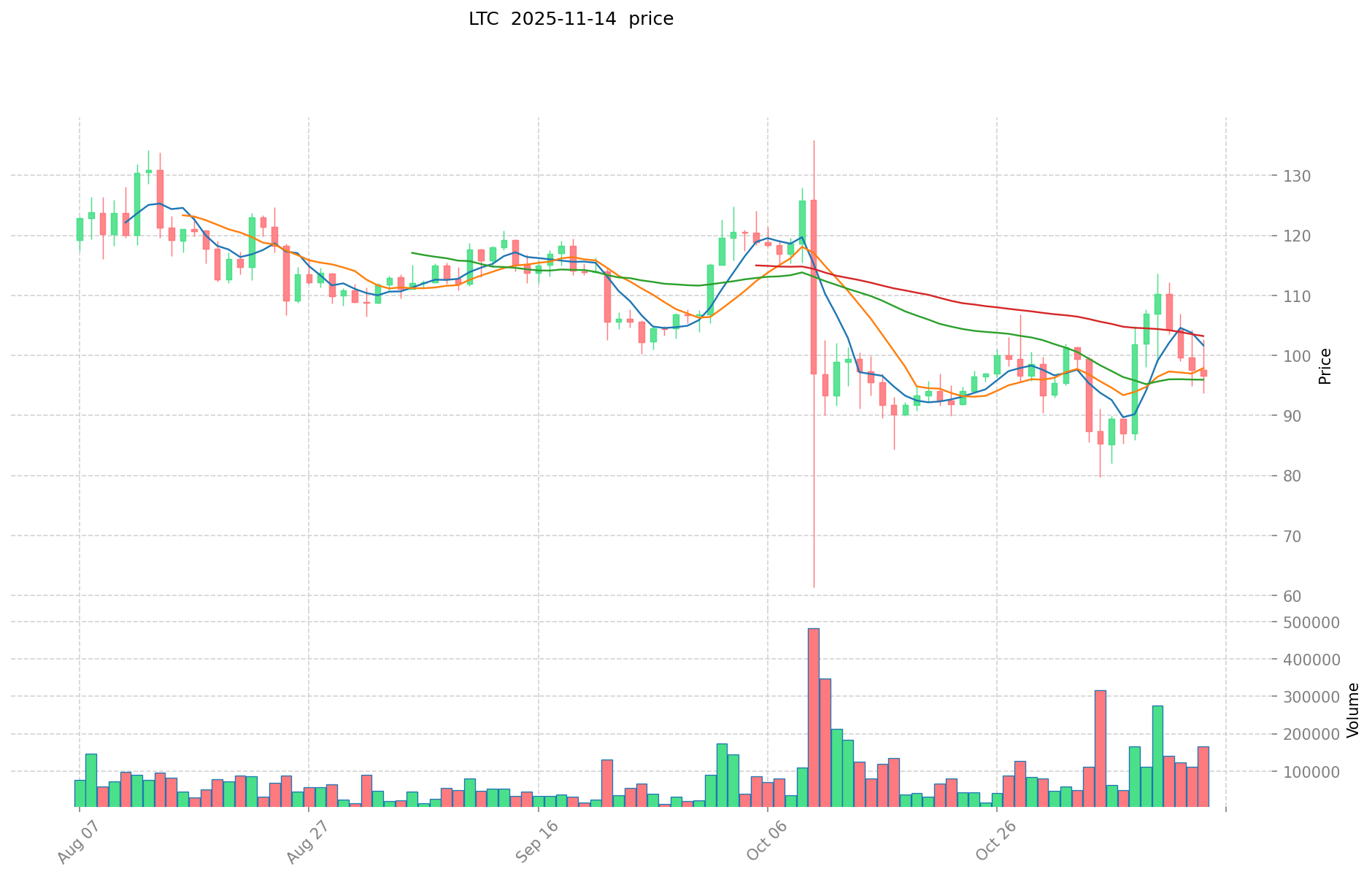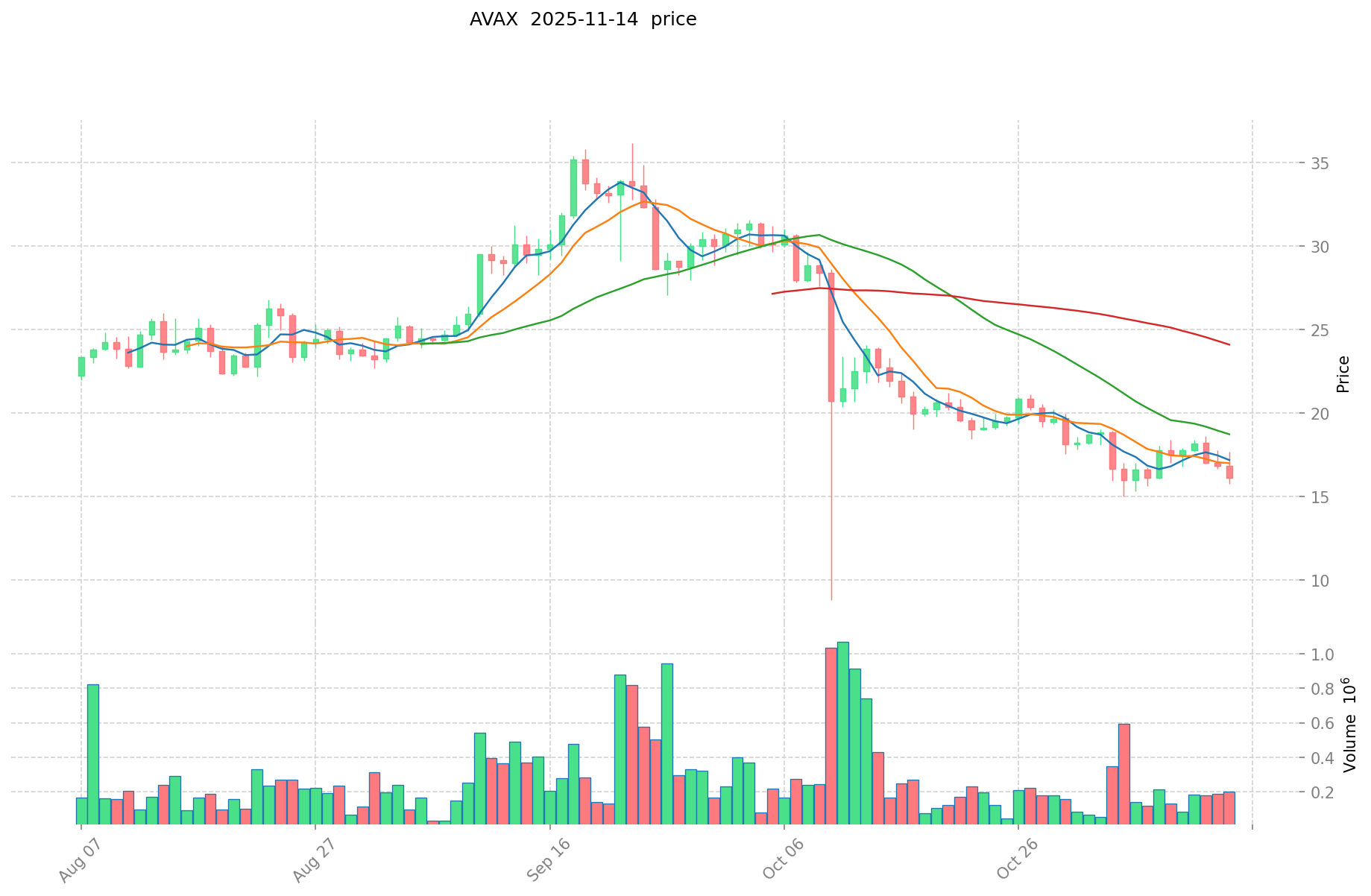LTC vs AVAX: Which Cryptocurrency Has More Potential for Long-Term Growth?
Introduction: LTC vs AVAX Investment Comparison
In the cryptocurrency market, Litecoin vs Avalanche comparison has always been a topic that investors can't ignore. The two not only have significant differences in market cap ranking, application scenarios, and price performance, but also represent different positioning in crypto assets.
Litecoin (LTC): Since its launch in 2011, it has gained market recognition for its faster transaction confirmation speed compared to Bitcoin.
Avalanche (AVAX): Since its inception in 2020, it has been hailed as a platform for launching decentralized applications and interoperable blockchains, with revolutionary consensus protocol.
This article will provide a comprehensive analysis of the investment value comparison between Litecoin and Avalanche, focusing on historical price trends, supply mechanisms, institutional adoption, technological ecosystems, and future predictions, and attempt to answer the question that investors care about most:
"Which is the better buy right now?"
I. Price History Comparison and Current Market Status
LTC (Coin A) and AVAX (Coin B) Historical Price Trends
- 2021: AVAX reached its all-time high of $144.96 on November 21, 2021, due to the growing popularity of the Avalanche network.
- 2021: LTC hit its all-time high of $410.26 on May 10, 2021, amid the broader cryptocurrency bull market.
- Comparative analysis: Since their respective all-time highs, LTC has fallen to $96.26, while AVAX has dropped to $15.56, representing significant declines for both coins in the current market cycle.
Current Market Situation (2025-11-14)
- LTC current price: $96.26
- AVAX current price: $15.56
- 24-hour trading volume: LTC $17,180,144.29 vs AVAX $3,561,575.27
- Market Sentiment Index (Fear & Greed Index): 16 (Extreme Fear)
Click to view real-time prices:
- View LTC current price Market Price
- View AVAX current price Market Price


II. Core Factors Affecting LTC vs AVAX Investment Value
Supply Mechanism Comparison (Tokenomics)
- Litecoin: Fixed supply cap of 84 million coins with halving mechanism occurring approximately every 4 years
- Avalanche: Total supply of 720 million AVAX with deflationary mechanism through transaction fee burning
- 📌 Historical pattern: LTC's halving events historically precede price rallies, while AVAX's deflationary model creates continuous supply pressure
Institutional Adoption and Market Applications
- Institutional holdings: Grayscale maintains both LTC and AVAX trusts, but AVAX has attracted more institutional interest in recent years through its subnets for enterprise solutions
- Enterprise adoption: LTC serves primarily as a payment and transfer network, while AVAX offers enterprise-grade blockchain solutions through customizable subnets
- Regulatory attitudes: Both assets face varying regulatory treatments globally, with LTC's longer history providing more regulatory clarity in most jurisdictions
Technical Development and Ecosystem Building
- Litecoin technical upgrades: MWEB (Mimblewimble Extension Block) implementation enhances privacy and scalability
- Avalanche technical development: Subnet architecture enables customizable blockchains with high TPS and near-instant finality
- Ecosystem comparison: LTC primarily functions as a payment network with limited smart contract capabilities, while AVAX supports a robust DeFi ecosystem, NFT marketplaces, and enterprise applications through its EVM-compatible C-Chain
Macroeconomic and Market Cycles
- Performance during inflation: LTC, with its fixed supply and Bitcoin-like properties, is often viewed as an inflation hedge, while AVAX's utility-focused value proposition is more aligned with technology adoption
- Macroeconomic monetary policy: Both assets show sensitivity to Federal Reserve policies and global liquidity conditions, with risk-on assets like AVAX typically experiencing higher volatility
- Geopolitical factors: LTC's simpler use case as digital silver provides utility in cross-border transactions, while AVAX's complex ecosystem may face more regulatory scrutiny in certain jurisdictions
III. 2025-2030 Price Prediction: LTC vs AVAX
Short-term Forecast (2025)
- LTC: Conservative $70.12 - $96.06 | Optimistic $96.06 - $102.78
- AVAX: Conservative $13.53 - $15.55 | Optimistic $15.55 - $17.26
Mid-term Forecast (2027)
- LTC may enter a bullish phase, with estimated prices ranging from $102.63 to $163.33
- AVAX may experience moderate growth, with prices projected between $12.42 and $21.41
- Key drivers: Institutional capital inflow, ETF developments, ecosystem expansion
Long-term Forecast (2030)
- LTC: Base scenario $94.65 - $163.19 | Optimistic scenario $163.19 - $192.56
- AVAX: Base scenario $13.30 - $22.55 | Optimistic scenario $22.55 - $27.96
Disclaimer: The above predictions are based on historical data and market analysis. Cryptocurrency markets are highly volatile and subject to rapid changes. These forecasts should not be considered as financial advice. Always conduct your own research before making investment decisions.
LTC:
| 年份 | 预测最高价 | 预测平均价格 | 预测最低价 | 涨跌幅 |
|---|---|---|---|---|
| 2025 | 102.7842 | 96.06 | 70.1238 | 0 |
| 2026 | 121.294962 | 99.4221 | 54.682155 | 3 |
| 2027 | 163.33062588 | 110.358531 | 102.63343383 | 14 |
| 2028 | 153.2659278528 | 136.84457844 | 123.160120596 | 42 |
| 2029 | 181.319066433 | 145.0552531464 | 139.253043020544 | 50 |
| 2030 | 192.560848551846 | 163.1871597897 | 94.648552678026 | 69 |
AVAX:
| 年份 | 预测最高价 | 预测平均价格 | 预测最低价 | 涨跌幅 |
|---|---|---|---|---|
| 2025 | 17.2605 | 15.55 | 13.5285 | 0 |
| 2026 | 21.8189825 | 16.40525 | 8.53073 | 5 |
| 2027 | 21.4055702 | 19.11211625 | 12.4228755625 | 22 |
| 2028 | 22.89249284425 | 20.258843225 | 14.9915439865 | 30 |
| 2029 | 23.51747815774125 | 21.575668034625 | 15.75023766527625 | 38 |
| 2030 | 27.957750639267075 | 22.546573096183125 | 13.302478126748043 | 44 |
IV. Investment Strategy Comparison: LTC vs AVAX
Long-term vs Short-term Investment Strategies
- LTC: Suitable for investors focused on payment scenarios and established network effects
- AVAX: Suitable for investors seeking ecosystem potential and DeFi exposure
Risk Management and Asset Allocation
- Conservative investors: LTC: 70% vs AVAX: 30%
- Aggressive investors: LTC: 40% vs AVAX: 60%
- Hedging tools: Stablecoin allocation, options, cross-currency portfolio
V. Potential Risk Comparison
Market Risks
- LTC: Vulnerability to Bitcoin market movements and payment adoption trends
- AVAX: Higher volatility due to newer market status and dependency on DeFi sector performance
Technical Risks
- LTC: Scalability, network stability
- AVAX: Potential consensus vulnerabilities, smart contract risks
Regulatory Risks
- Global regulatory policies may impact both differently, with LTC potentially facing less scrutiny due to its simpler use case
VI. Conclusion: Which Is the Better Buy?
📌 Investment Value Summary:
- LTC advantages: Established history, Bitcoin-like properties, potential as digital silver
- AVAX advantages: Robust ecosystem, high-performance blockchain, enterprise adoption potential
✅ Investment Advice:
- New investors: Consider a higher allocation to LTC for its established market presence
- Experienced investors: Balanced approach with exposure to both LTC and AVAX
- Institutional investors: Explore AVAX for its enterprise solutions while maintaining LTC for portfolio diversification
⚠️ Risk Warning: Cryptocurrency markets are highly volatile. This article does not constitute investment advice. None
VII. FAQ
Q1: What are the key differences between Litecoin (LTC) and Avalanche (AVAX)? A: Litecoin is primarily a payment network with faster transaction speeds than Bitcoin, while Avalanche is a platform for decentralized applications and interoperable blockchains. LTC has a fixed supply cap of 84 million coins, while AVAX has a total supply of 720 million with a deflationary mechanism.
Q2: Which cryptocurrency has performed better historically? A: Both cryptocurrencies have experienced significant price fluctuations. AVAX reached its all-time high of $144.96 in November 2021, while LTC hit $410.26 in May 2021. Since then, both have seen substantial declines, with LTC at $96.26 and AVAX at $15.56 as of the current market situation.
Q3: How do institutional adoption and market applications differ for LTC and AVAX? A: LTC primarily serves as a payment and transfer network, while AVAX offers enterprise-grade blockchain solutions through customizable subnets. AVAX has attracted more recent institutional interest, particularly for its enterprise solutions, while LTC has a longer history of regulatory clarity in most jurisdictions.
Q4: What are the price predictions for LTC and AVAX in the coming years? A: By 2030, LTC is projected to range from $94.65 to $192.56 in optimistic scenarios, while AVAX is estimated between $13.30 and $27.96. However, these predictions are subject to market volatility and should not be considered financial advice.
Q5: How do the risk profiles of LTC and AVAX compare? A: LTC is generally considered less volatile due to its established history and simpler use case, making it potentially suitable for more conservative investors. AVAX, being newer and more closely tied to the DeFi sector, may present higher volatility and potential returns, appealing to more aggressive investors.
Q6: What factors should investors consider when choosing between LTC and AVAX? A: Investors should consider their risk tolerance, investment horizon, and interest in specific blockchain applications. LTC may be more suitable for those focused on payment scenarios and established networks, while AVAX might appeal to investors seeking exposure to a robust DeFi ecosystem and enterprise blockchain solutions.
Q7: How might regulatory changes impact LTC and AVAX differently? A: Due to its simpler use case as a payment network, LTC may face less regulatory scrutiny compared to AVAX. AVAX's complex ecosystem, including DeFi and enterprise applications, could potentially attract more regulatory attention, especially in jurisdictions with stricter oversight of crypto assets.
Share
Content